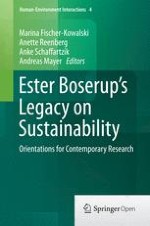Open Access 2014 | Open Access | Book

Ester Boserup’s Legacy on Sustainability
Orientations for Contemporary Research
Editors: Marina Fischer-Kowalski, Anette Reenberg, Anke Schaffartzik, Andreas Mayer
Publisher: Springer Netherlands
Book Series : Human-Environment Interactions